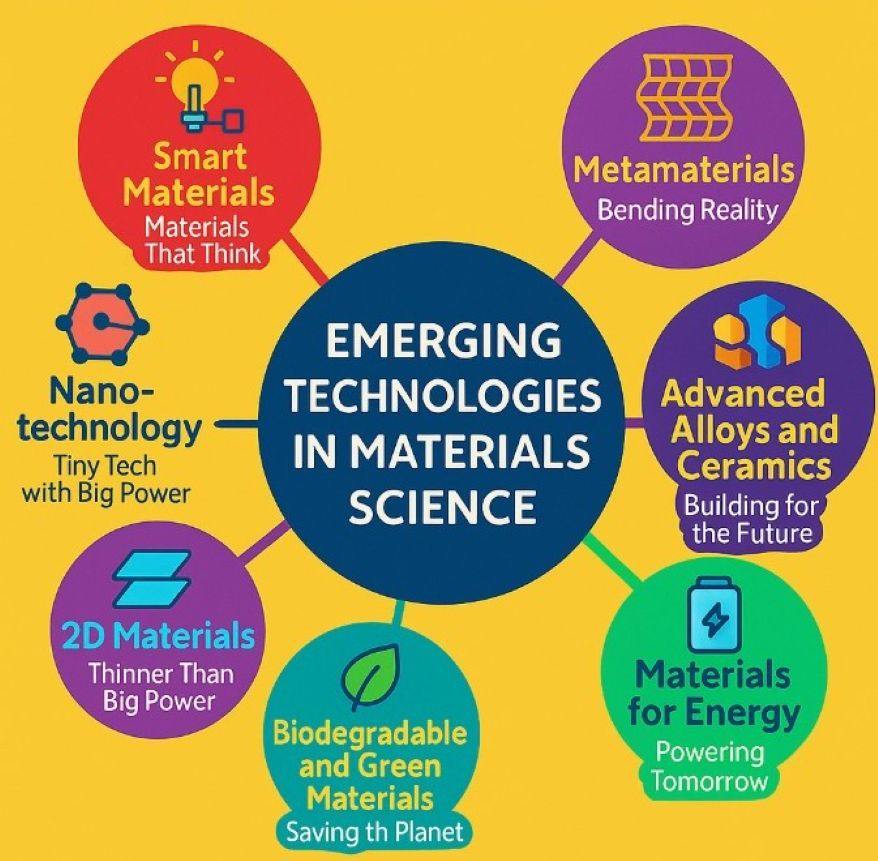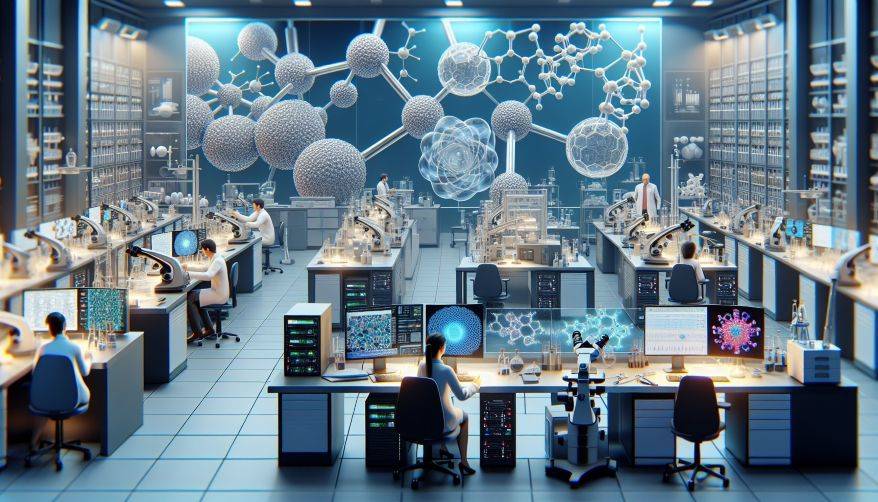Redefining the Future: Emerging Technologies in Materials Science
What is Materials Science?
Have you ever wondered what makes your phone screen so tough, or how airplanes are made light but strong? The answer lies in a fascinating field called Materials Science. Thus, this branch of science discovers and designs new materials. The building blocks of everything around us with special properties that can transform the way we live.
From creating biodegradable plastics to building super-fast computers, materials science is all around us. As technology advances, scientists develop new materials that could revolutionize medicine and space travel. Let’s dive into some of the most exciting new technologies in materials science today!

1. Smart Materials: Materials That Think
Imagine clothes that adjust to temperature, windows that tint automatically when it’s too bright, or buildings that heal their cracks. Therefore, these are all possible because of smart materials.
Smart materials can respond to changes in their environment, like heat, light, or pressure, and change their properties. Here are some cool examples:
- Shape Memory Alloys (SMAs): These metals “remember” their original shape. Bend them out of shape, heat them, and they’ll return to their original form! Used in things like eyeglass frames and even medical stents.
- Thermochromic Materials: These change color with temperature. You see them in mood rings or mugs that change color when you pour in hot coffee.
- Piezoelectric Materials: These produce electricity when squeezed or pressed. You can use them to power small devices like sensors or even to charge your phone through your shoes while walking!
Smart materials are already changing industries like fashion, construction, and healthcare.
2. Nanotechnology: Tiny Tech with Big Power
Nanotechnology deals with materials at the scale of atoms and molecules; that’s about 100,000 times smaller than the width of a human hair! At this scale, materials behave very differently and can be incredibly strong, lightweight, or conduct electricity in unique ways.
Why is nanotechnology so exciting?
- Nano-coatings make surfaces waterproof, anti-bacterial, or scratch-resistant. You’ll find them on glasses, phones, and even car paint.
- Carbon Nanotubes are tiny cylinders made of carbon atoms. They’re stronger than steel and lighter than aluminum. They could lead to better batteries, super-fast computers, and even space elevators!
- Gold Nanoparticles are being used in cancer treatment. Thus, they can deliver medicine directly to tumor cells without harming healthy ones.
Nanotechnology has the power to improve almost every industry, from electronics to energy to medicine.

3. 2D Materials: Thinner Than Paper, Stronger Than Steel
What makes graphene special?
- It’s super thin — a million times thinner than a sheet of paper.
- It’s stronger than steel but incredibly flexible.
- Conducts electricity better than copper.
- It’s almost completely transparent!
Graphene and other 2D materials like boron nitride and molybdenum disulfide are being used in flexible electronics, fast-charging batteries, and even water purification systems.
Imagine folding your phone like paper or installing a transparent solar panel on your window—that’s the promise 2D materials offer.
4. Biodegradable and Green Materials: Saving the Planet
With plastic pollution and climate change on the rise, scientists are working hard to create sustainable materials that are safe for the environment.
Here are some breakthroughs in green materials:
- Biodegradable Plastics made from corn, sugarcane, or algae break down naturally without harming the environment.
- Mycelium Leather is made from the root system of mushrooms and uses it as an eco-friendly alternative to animal leather.
- Recycled Composite Materials use waste like old plastics and turn them into construction materials or furniture.
These green innovations help reduce waste and lower our carbon footprint, all while creating useful new products.
5. Metamaterials: Bending Reality
Ever wish for an invisibility cloak like in the movies? Further, it may not be as far-fetched as it sounds, thanks to metamaterials.
Metamaterials are engineered to have properties that don’t exist in nature. Thus, they can bend light, sound, and even electromagnetic waves in strange ways.
Cool possibilities with metamaterials:
- Invisibility Cloaks: By bending light around an object, they can make it seem invisible at least to certain types of light.
- Super Lenses: These can zoom in far beyond the limit of normal microscopes, helping scientists see viruses or molecules in detail.
- Noise-Cancelling Structures: Using metamaterials to design buildings or machines that block certain sounds, making them quieter.
Though these technologies are still developing. Moreover, they could soon change how we see or don’t see the world.
6. Advanced Alloys and Ceramics: Building for the Future
Materials for the future need to be strong, durable, and resistant to extreme conditions like those in space or deep under the ocean. That’s where advanced alloys and ceramics come in.
- Superalloys are used in jet engines because they can survive extreme heat and stress.
- Ceramic Composites are light but very hard. Hence, they’re used in armor, spacecraft, and cutting tools.
- High-Entropy Alloys mix five or more metals to create super-strong, corrosion-resistant materials.
These advanced materials are critical for building next-generation aircraft, cars, and infrastructure that can last longer and perform better.

7. Materials for Energy: Powering Tomorrow
The future of energy depends heavily on materials science. To move away from fossil fuels, we need better batteries, solar cells, and fuel cells. Moreover, this means developing new materials.
- Solid-state batteries use solid materials instead of liquids. Hence, they’re safer, last longer, and can charge faster.
- Perovskite Solar Cells are a new type of solar panel material, cheaper and more efficient than traditional silicon.
- Hydrogen Storage Materials– Designed to safely store and release hydrogen, a clean fuel of the future.
By improving materials, we can store and use energy more efficiently. Also, help combat climate change.
Conclusion: Why Materials Science Matters
Materials science is a hidden hero in our modern world. It’s the reason we have powerful smartphones, clean energy, and advanced medicine. Moreover, as scientists discover and improve new materials, they unlock amazing possibilities. Turning today’s science fiction into tomorrow’s everyday reality.
Whether you dream of inventing wearable tech, saving the environment, or building rockets to Mars, materials science is a key part of the journey. So the next time you pick up your phone, ride a bike, or drink from a water bottle, take a moment to wonder: what materials make it, and what could it become?
References
- Gao, C., Min, X., Fang, M., Tao, T., Zheng, X., Liu, Y., Wu, X., & Huang, Z. (2021). Innovative materials science via machine learning. Advanced Functional Materials, 32(1). https://doi.org/10.1002/adfm.202108044
- Pyzer-Knapp, E. O., Pitera, J. W., Staar, P. W. J., Takeda, S., Laino, T., Sanders, D. P., Sexton, J., Smith, J. R., & Curioni, A. (2022). Accelerating materials discovery using artificial intelligence, high performance computing and robotics. Npj Computational Materials, 8(1). https://doi.org/10.1038/s41524-022-00765-z
- Raabe, D. (2023). The Materials Science behind Sustainable Metals and Alloys. Chemical Reviews, 123(5), 2436–2608. https://doi.org/10.1021/acs.chemrev.2c00799
- DeCost, B., Hattrick-Simpers, J., Trautt, Z., Kusne, A., Campo, E., & Green, M. (2020). Scientific AI in materials science: a path to a sustainable and scalable paradigm. Machine Learning Science and Technology, 1(3), 033001. https://doi.org/10.1088/2632-2153/ab9a20
Additionally, to stay updated with the latest developments in STEM research, visit ENTECH Online. Basically, this is our digital magazine for science, technology, engineering, and mathematics. Furthermore, at ENTECH Online, you’ll find a wealth of information.






